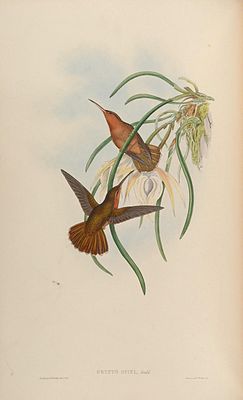Bronze tailed shadow hummingbird
| Bronze tailed shadow hummingbird | ||||||||||
|---|---|---|---|---|---|---|---|---|---|---|

Bronze tailed shadow hummingbird |
||||||||||
| Systematics | ||||||||||
|
||||||||||
| Scientific name | ||||||||||
| Glaucis dohrnii | ||||||||||
| ( Bourcier & Mulsant , 1852) |
The bronze- tailed shadow hummingbird ( Glaucis dohrnii , Syn . : Ramphodon dohrnii ), also known as the bronze-tailed hermit or hook-billed hermit , is a rare hummingbird from Brazil . There are no known subspecies. It is therefore considered to be monotypical .
description
Its length is between 12 and 13.7 cm. The female is slightly larger than the male. In both sexes, the skull is bronze-green. The face is dark. Behind the eyes a white cheek stripe runs towards the shoulder. The top and tail show a metallic bronze green, with the male having a white tail tip. The underside is cinnamon colored. The heavy, straight beak is hook-shaped at the tip, black on top and yellow-white underneath. The legs are yellow.
distribution
The occurrence is limited to a few distant places in eastern Brazil. These are the Monte Pascoal National Park, Serra de Itamaruja and Estação Veracruz in Bahia and the Linhares Forest Reserve in Espírito Santo . Historically, it was also found in the far east of Minas Gerais and in the state of Rio de Janeiro .
Way of life
It lives in moist forests and prefers to stay on river beds whose banks are overgrown with heliconias . Generally it can be found in the forest interior, but it has occasionally been observed on ornamental flowers. The breeding season is between September and February. The nest is built on the inside of banana and palm leaves and expanded with lichen and larger plant parts. The incubation period is 15 days, the young leave the nest after 27 days.
Danger
The bronze-tailed shadow hummingbird was probably never particularly common, but the clearing of the forests and the destruction of its habitat have affected it so badly that only between 250 and 1000 specimens have survived. Although it has been recorded in two nature reserves, it enjoys insufficient protection. Most of all, he suffered from the fires and road construction by the settlers. It is listed in Appendix I of the CITES agreement and is listed by the IUCN as endangered (highly endangered).
Etymology and history of research
Jules Bourcier Martial Étienne Mulsant and described the hummingbird under the protonym Trochilus dohrnii . Only later was it added to the genus Glaucis .
The term "Glaucis" comes from the Greek word "glaukos γλαυκός " for "blue-gray, glauk , light green". The specific epithet was named after the German entomologist Carl August Dohrn , a friend of the authors and then president of the Entomological Society in Stettin.
literature
- J. Del Hoyo, A. Elliot, J. Sargatal (Eds.): Handbook of the Birds of the World. Volume 5: Barn-Owls to Hummingbirds . Lynx Edicions, Barcelona. 1999. ISBN 84-87334-25-3
- James A. Jobling: Helm Dictionary of Scientific Bird Names . Christopher Helm, London 2010, ISBN 978-1-4081-2501-4 .
- Jules Bourcier, Étienne Mulsant: Description of quelques nouvelles espèces d'oiseaux-mouches . In: Annales des sciences physiques et naturelles, d'agriculture et d'industrie (= 2 ). tape 4 , 1852, p. 139-144 ( online [accessed March 13, 2012]).
Web links
- Glaucis dohrnii inthe IUCN Red List of Threatened Species 2012.2. Listed by: BirdLife International, 2012. Retrieved January 26, 2013.
- BirdLife International: Species Factsheet - Hook-billed Hermit ( Glaucis dohrnii ) . Retrieved January 26, 2013.
- Videos, photos and sound recordings for Hook-billed Hermit (Glaucis dohrnii) in the Internet Bird Collection
- Bronze- tailed shadow hummingbird ( Glaucis dohrnii ) at Avibase; Retrieved January 26, 2013.
- Glaucis dohrnii in the Integrated Taxonomic Information System (ITIS). Retrieved January 26, 2013.
- xeno-canto: Sound recordings - Hook-billed Hermit ( Glaucis dohrnii )
- Beija flor (Port.)
Individual evidence
- ^ IOC World Bird List Hummingbirds
- ↑ a b Jules Bourcier u. a., p. 139
- ↑ James A. Jobling, p. 174
